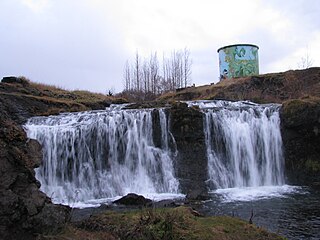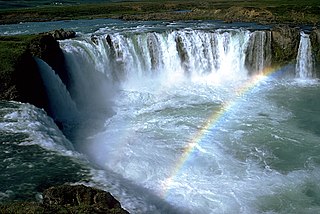 W
WIceland is unusually suited for waterfalls. This island country has a north Atlantic climate that produces frequent rain and snow and a near-Arctic location that produces large glaciers, whose summer melts feed many rivers. As a result, it is home to a number of large and powerful waterfalls.
 W
WÁlafoss is a waterfall on the river Varmá in Mosfellsbær, Iceland. A wool factory of the same name has adjoined the waterfall since 1896, when a local farmer imported machinery to process wool using the energy from the waterfall. During World War II, barracks were constructed there for British soldiers. Álafoss played a major role in the founding and growth of the town of Mosfellsbær. The band Sigur Rós has a studio named Sundlaugin at Álafoss, and the otherwise untitled fifth track on the band's "( )" album is nicknamed after the area.
 W
WThe Aldeyjarfoss waterfall is situated in the Highlands of Iceland at the northern part of the Sprengisandur Highland Road. The river Skjálfandafljót drops here from a height of 20m. The basalt belongs to a lava field called Frambruni or Suðurárhraun, hraun being the Icelandic word for lava.
 W
WBarnafoss is also known as Bjarnafoss, which was its previous name. Barnafoss is near Hraunfossar which burst out of Hallmundarhraun which is a great lava plain. Barnafoss is a waterfall in Western Iceland, about 100 kilometres (62 mi) from Reykjavík. Barnafoss is on the river Hvítá in Borgarfjörður. Hraunfossar flows out of a lava field into Hvítá near Barnafoss, creating a stunning scenery.
 W
WThe Denmark Strait cataract is an undersea waterfall found on the western side of the Denmark Strait in the Atlantic Ocean, on the Arctic Circle between Iceland and Greenland. It is the world's highest underwater waterfall, with water falling almost 3,505 metres.
 W
WDettifoss is a waterfall in Vatnajökull National Park in Northeast Iceland, and is reputed to be the second most powerful waterfall in Europe after the Rhine Falls. Dettifoss is situated on the Jökulsá á Fjöllum river, which flows from the Vatnajökull glacier and collects water from a large area in Northeast Iceland. The sediment-rich runoff colours the water a greyish white.
 W
WDynjandi is a series of waterfalls located in the Westfjords, Iceland. The waterfalls have a total height of 100 metres (330 ft).
 W
WFagrifoss is waterfall situated in Southeast Iceland near the Lakagígar region. It is located along the 4x4 road F206 approximately 24 km (15 mi) from Kirkjubæjarklaustur and 40 km (25 mi) from Laki. Access to the waterfall requires the crossing of a river ford, for which a 4x4 vehicle is needed.
 W
WThe Faxi waterfall is located on the Golden Circle, a popular tourist trail east of Reykjavik. The waterfall is located on the Tungufljót river.
 W
WLike the Háifoss, the small valley Gjáin with its small waterfalls, ponds, and volcanic structures is situated in the south of Iceland. It is to be found at about half an hour walking distance from the historical farm Þjóðveldisbærinn Stöng.
 W
WGljúfrafoss or Gljúfrabúi is a small waterfall north of the larger falls of Seljalandsfoss in Iceland. The falls are partially obscured by the cliff rock, but hikers can follow a trail to enter the narrow canyon where the water plummets to a small pool. There is also a winding trail nearby and a wooden staircase to enable sightseers to climb roughly halfway up and view the falls from another perspective.
 W
WGluggafoss is a waterfall in southern Iceland, specifically in the Fljótshlíð area. As the most prominent member of a series of waterfalls running from the river Merkjá, it is also known as Merkjárfoss; both names are acknowledged on an on-site signpost. The waterfall is accessible off Route 261, some 17.3 km from the closest major town, Hvolsvöllur.
 W
WGlymur is the second-highest waterfall in Iceland, with a cascade of 198 m. It was long regarded as the tallest until being surpassed by Morsárfoss, a newly measured waterfall near Morsárjökull in 2011.
 W
WGoðafoss is a waterfall in northern Iceland. It is located along the country's main ring road at the junction with the Sprengisandur highland road. The water of the river Skjálfandafljót falls from a height of 12 metres over a width of 30 metres. The river rises in the Icelandic highlands and runs through the Bárðardalur valley.
 W
WThe Granni is a waterfall that cascades into the Þjórsá valley right beside the Háifoss. These two waterfalls did not have a name until the beginning of the 19th century, but Nágranni or granni is the Icelandic word for neighbor while Hái means tall. The name of the waterfall is based on the proximity to the neighbouring waterfall Háifoss, which is less than 250 meters away and fed by the same river. The river Fossá í Þjórsárdal is divided into two arms some 750 meters upstream from the waterfalls. Granni has a height of 101 meters and less power than the 122 meters high Háifoss. Downstream at the bottom the two separate rivers converge again into the Þjórsá river. Both waterfalls can be seen from a sightseeing platform which is on the south side of the falls. The volcano Hekla is within sight in the background.
 W
WGullfoss is a waterfall located in the canyon of the Hvítá river in southwest Iceland.
 W
WHafragilsfoss is a waterfall in Iceland.
 W
WThe waterfall Háifoss is situated near the volcano Hekla in southern Iceland. The waterfall Granni is next to it. The river Fossá, a tributary of Þjórsá, drops here from a height of 122 m. This is the fourth highest waterfall of the island, after Morsárfoss, Glymur and Hengifoss.
 W
WHengifoss is the third highest waterfall in Iceland, 128 meters. It is located in Hengifossá in Fljótsdalshreppur, East Iceland. It is surrounded by basaltic strata with thin, red layers of clay between the basaltic layers. Fossilized trunks of coniferous trees, sensitive to cold, and lignite, which depict warmer climates during the latter part of Tertiary. Further down the Hengifossá river is Litlanesfoss, notable for the columnar jointed volcanics around it. Hengifoss is the most popular hiking site in East Iceland with path leading from the parking lot to the falls. It takes 40–60 minutes to walk to the waterfall.
 W
WHjálparfoss is one of several waterfalls in the south of Iceland situated in the lava fields north of the stratovolcano Hekla near the point where the rivers Fossá and Þjórsá join. Hjálparfoss is located about 30 kilometres (19 mi) east of the village Flúðir and can be reached by a gravel road off Route 32 that winds through the Vikrar lava fields. About 5 kilometres (3.1 mi) south of Hjálparfoss lies Þjófafoss; further east are Háifoss on the Fossá and Tangafoss on the Þjórsá.
 W
WHraunfossar is a series of waterfalls formed by rivulets streaming over a distance of about 900 metres out of the Hallmundarhraun, a lava field which flowed from an eruption of one of the volcanoes lying under the glacier Langjökull. The waterfalls pour into Hvítá (Borgarfjörður), from ledges of less porous rock in the lava. The name comes from the Icelandic word for lava (hraun) and the word for waterfalls (fossar). The Hraunfossar are situated near Húsafell and Reykholt and the Víðgelmir lava tube is close by.
 W
WMorsárfoss is a waterfall in Vatnajökull National Park, Iceland. Measurements showed that one of them was at least 240 meters in total height, making it the highest waterfall in Iceland. Morsárfoss became visible in 2007 when Morsárjökull, an outlet glacier of Vatnajökull glacier, started melting.
 W
WÓfærufoss is a waterfall situated in the Eldgjá chasm in the western part of Vatnajökull National Park, Iceland. Until the early 1990s a natural bridge spanned the falls, but it collapsed from natural causes.
 W
WÖxarárfoss is a waterfall in Þingvellir National Park, Iceland. It flows from the river Öxará over the Almannagjá. The pool at the base of the waterfall is filled with rocks and is often extremely icy during winter.
 W
WSelfoss is a waterfall on the river Jökulsá á Fjöllum in the north of Iceland. The river drops over a number of waterfalls over about 30 km before flowing into Öxarfjörður, a bay of the Arctic Sea. The river originates as melt water from the glacier Vatnajökull and therefore the water flow varies depending on the season, the weather and volcanic activity.
 W
WSeljalandsfoss is a waterfall in Iceland. Seljalandsfoss is located in the South Region in Iceland right by Route 1 and the road that leads to Þórsmörk Road 249. The waterfall drops 60 m (197 ft) and is part of the Seljalands River that has its origin in the volcano glacier Eyjafjallajökull. Visitors can walk behind the falls into a small cave.
 W
WSkógafoss is a waterfall on the Skógá River in the south of Iceland at the cliff marking the former coastline. After the coastline had receded, the former sea cliffs remained, parallel to the coast over hundreds of kilometres, creating together with some mountains a clear border between the coastal lowlands and the Highlands of Iceland.
 W
WSvartifoss is a waterfall in Skaftafell in Vatnajökull National Park in Iceland, and is one of the most popular sights in the park. It is surrounded by dark lava columns, which gave rise to its name. Other well-known columnar jointing formations are seen at the Giant's Causeway in Northern Ireland, Devil's Tower in Wyoming, United States and on the island of Staffa in Scotland. There are also similar formations throughout Iceland, including a small cave on the beach of Reynisdrangar.
 W
WSystrafoss is a waterfall in Iceland, found at Kirkjubæjarklaustur in Skaftárhreppur in Suðurland area.
 W
WÞjófafoss (Thjofafoss) is located on the river Þjórsá on the east side of the Merkurhraun lava fields in the south of Iceland, at the southwest tip of the hill Búrfell. A viewing point for the waterfall can be accessed by a gravel track that leads about 4 kilometres (2.5 mi) northwest from Route 26 or by a track that leads south from Route 32 past the hydroelectric power station Búrfellsstöð and Hjálparfoss.
 W
WUrriðafoss is a waterfall located in the river Þjórsá in southwest Iceland. With a flow rate of 360 m³/s, it has the highest average water flow of any waterfall in Iceland, and the second highest in Europe behind the Rheinfall.